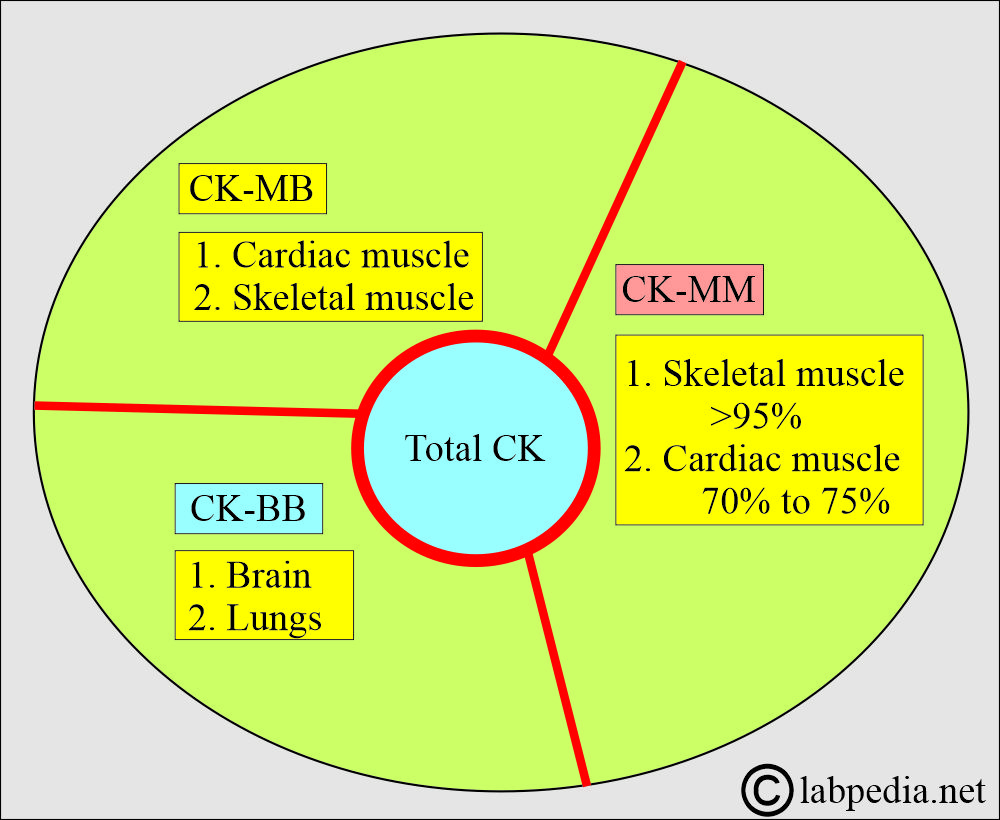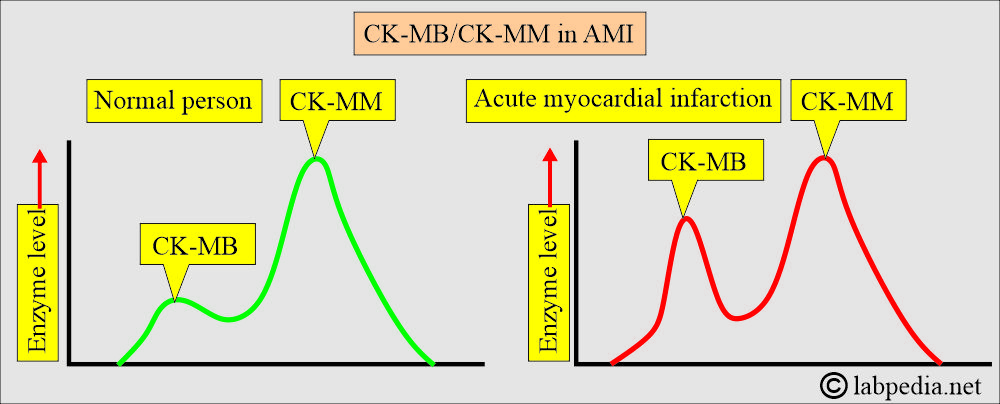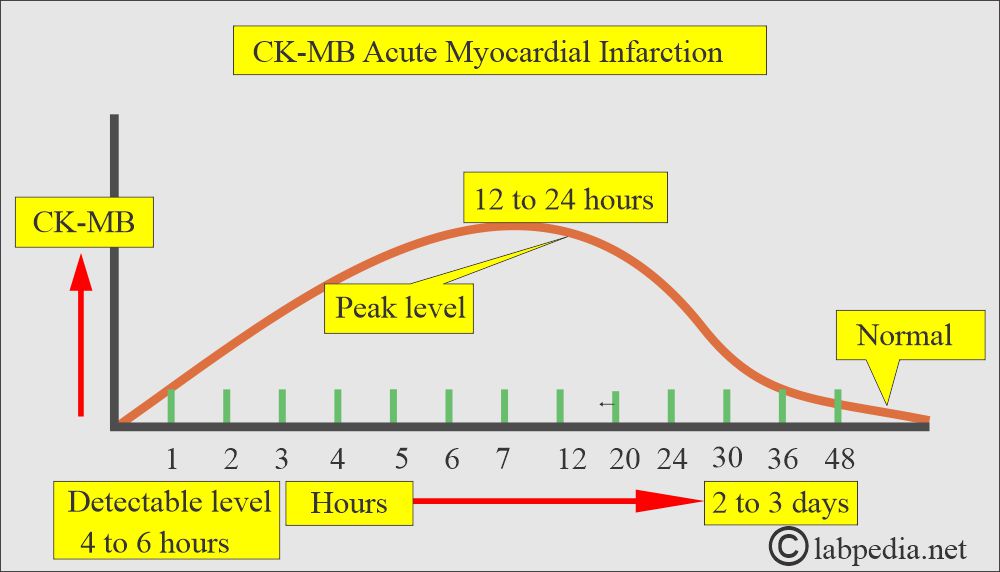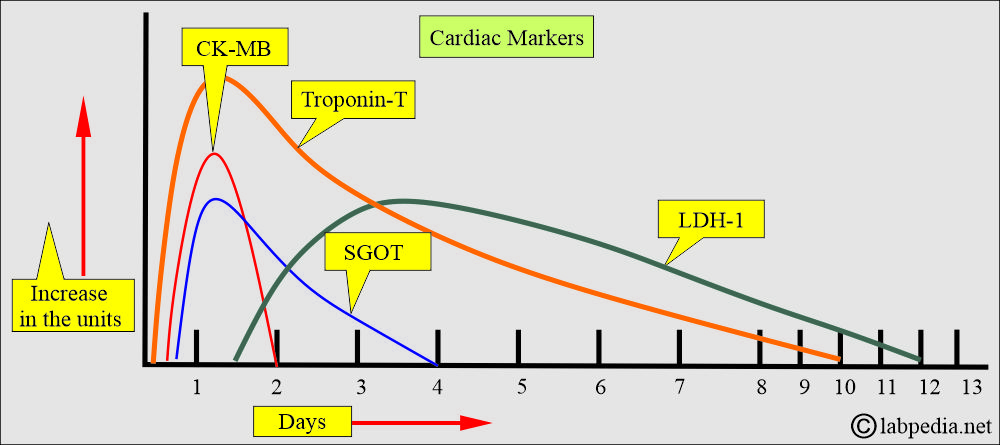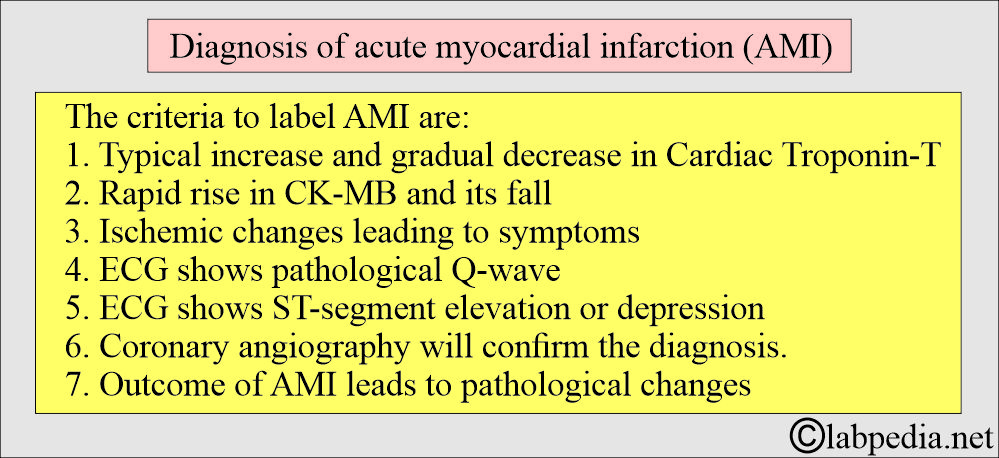Cardiac marker:- Part 2 – CK-MB (Cardiac Enzyme)
CK-MB (Cardiac Enzyme)
What sample is needed for CK-MB?
- The test is performed on the serum (clotted blood, 3-5 mL) of the patient.
- It also helps in quantifying myocardial muscle damage.
- The sample is stable for 4 to 8 hours at room temperature.
- 1 to 2 days at 4 °C.
- One month at -20 °C.
What are the Indications for CK-MB?
- To diagnose myocardial muscle injury (MI).
- It is an early marker of acute myocardial infarction. This is considered an early gold-standard diagnostic tool.
- It detects reinfarction or extension of myocardial damage after 72 hours.
- It is needed for reperfusion after thrombolytic therapy.
- This may replace troponins when advised within 24 hours of the onset of symptoms.
What are the Precautions for CK-MB?
- Avoid intramuscular injection in patients with cardiac disease. I/M injection may raise the CK-MB level.
- Strenuous exercise and recent surgery may increase the level of CK-MB.
- Early pregnancy may produce a decreased level of CK-MB.
- Drugs that may increase the level include alcohol, ampicillin, amphotericin B, aspirin, anesthetics, dexamethasone (Decadron), furosemide (Lasix), lidocaine, morphine, propranolol, lithium, captopril, clofibrate, colchicine, and statins.
How will you define CK-MB?
- CK-MB is an isoenzyme of Creatinine kinase.
- It is present in the cardiac, skeletal muscles, and brain.
- CK-BB is found in the brain and nervous tissue; it is also present in the serum of newborn babies and in malignancies that exhibit embryonic tissue differentiation.
- The more rapid rise in CK-MB and fall in the CK-MB marker of myocardial infarction.
How will you discuss the pathophysiology of CK-MB?
- CK, creatine kinase; adenosine triphosphate:
- Creatine N-phosphotransferase is a dimeric enzyme with a 82 kDa weight.
- It will catalyze the reversible phosphorylation of creatine by adenosine triphosphate (ATP).
- When a muscle contracts, ATP is converted into ADP (adenosine diphosphate).
- CK catalyzes the conversion of ATP to ADP using phosphocreatine (creatine phosphate) as the phosphorylation reservoir.
- Creatinine kinase comprises two polypeptide chains, B and M, making up three distinct forms. These are the cytosolic enzymes.
- Distinct genes encode the M and B subunits.
What isoenzymes does the CK have?
- CK-1 =BB (CK-BB) = It is found predominantly in the brain and lungs.
- CK-2 =MB (CK-MB) = Predominantly found in the cardiac muscles.
- CK-MB is primarily found in the cardiac muscle, accounting for 25% to 30% of total myocardial CPK.
- Skeletal muscle contains a small fraction of CK-MB, 3% to 5%.
- CK-3 =MM (CK-MM) = It is found in the skeletal muscles.
What is the distribution of the creatinine kinase isoenzymes?
| Tissue where CK is found | CK-BB | CK-MB | CK-MM |
|
|
|
|
|
|
|
|
|
|
|
|
|
|
|
|
|
|
|
|
|
|
|
|
|
|
|
|
What is the CK-MB significance?
- CK-MB is a cardiac marker released into the blood circulation when damage (necrosis) to the cardiac muscles occurs.
- CK-MB release into the blood circulation is detected within 6 to 18 hours of the onset of acute myocardial infarction.
- Because of the protein degradation mechanism that eliminates CK-MB from the blood circulation, the short window may result in the CK-MB peak level being missed.
What is the role of CK-MB in the diagnosis of Acute Myocardial Infarction?
- It is specific for diagnosing cardiac muscle damage in the first few hours of Myocardial Infarction (MI).
- CK-MB is high in cardiac muscle and low in skeletal muscle, which is <3%.
- Around 10% of people have normal CK, while CK-MB is raised in myocardial infarction.
- This may be raised in skeletal muscle injury but not in injury due to injections and exercise.
- CK-MB is not raised in pulmonary embolism unless there is a heart muscle injury.
- In Duchenne’s muscular dystrophy, in the early stages, CK-MB is raised.
- CK-MB may be increased in patients with gangrene or severe ischemia of the limbs.
- If there is a persistent increase in CK-MB greater than 30% to 40% of the total CK, it, it indicates malignancy.
- CK-MB can be reported as:
- % of the total CPK = CK-MB/Total CPK.
- It can be measured directly by an immunoassay.
What is the CK-MB relative index?
- This is done to avoid skeletal muscle injury with myocardial muscle damage.
- Calculation:
- CPK-MB/total CPK
- If CPK-MB = 3.0 ng/mL
- Relative index = ≥2.5
- This is highly suggestive of myocardial injury.
- If CPK-MB = >3.0 ng/mL
- Relative index = <2.5
- Not diagnostic for myocardial injury.
When does CK-MB begin to rise, and what interpretations can be made from this rise?
- CK-MB begins to rise 3 to 6 hours after the onset of Acute Myocardial infarction (AMI).
- The peak is between 12 to 24 hours.
- It returns to normal in 24 to 48 hours.
- There is a rough correlation between the level of CK-MB and the extent of myocardial muscle damage.
- CK-MB levels increase in 2/3 of patients after 72 hours of the AMI.
What are the causes of False-negative CK-MB results?
- Poor sample timing, such as only one sample per 24 hours.
- Sample <4 hours before the onset of AMI.
- Sample after >72 hours of AMI.
- A small infarct may not significantly increase the CK-MB level.
- Take the blood sample on admission or immediately upon the onset of acute chest pain.
- Then repeat the sample at 6, 12, 18, and 24 hours after the initial measurement.
- Some of the hospitals repeat 3 samples, and some take 4 samples.
- 3 samples method: Take an immediate sample, and then at 12 and 24 hours.
- 4 samples method: Take an immediate sample, and then at 8, 16, and 24 hours.
- There is controversy about whether total CK or CK-MB level rises in the case of ischemia only.
- If you take LDH (isoenzyme) and CK-MB at the same time. The diagnostic specificity will increase.
- If an LDH blood sample is taken at 24 and 48 hours, while a CK-MB sample is taken immediately at 12 and 24 hours.
- In that case, the specificity of AMI reaches 95% or more.
- It reaches a peak in 12 to 24 hours.
- In one of the references:
- CK raised level in the first sample was 18%
- In the first 12 hours, the sample was 50%.
- In a 24-hour sample, the percentage was 4%.
- CK has not raised the level was 18%.
- Troponin is a more specific cardiac marker than CK-MB.
What are the disadvantages of CK-MB?
- Diagnosis can not be based on one sample value.
- A rapid return to normal CK-MB levels makes it a poor marker after 72 hours of symptoms.
- CK-MB and total CK are decreased after cardiac surgery.
- A diagnosis of AMI can not be made until >12 to 24 hours after cardiac surgery.
- CK-MB and total CK can be elevated in chronic diseases and during exercise.
- If CK-MB >20% or persists >48 to 72 hours considered atypical CK-MB.
What are the Normal CK-MB values?
Source 1
- Normal = 5 to 25 IU/L
- Or it is 3% to 5% of the Total CK.
- Single estimation is not reliable.
- Multiple samples are estimated for CK-MB.
Source 2
- CK – MB = 0 to 10 U/L
- CK – MB = 0 to 9 µg/L
- CK – MB by Immunoassay = <10 µg/L
- CK – MB On electrophoresis = <4 to 6%
Source 3
- CK-MB = 0 to 3 ng/mL
- Or 0 to 3 µg/L.
What are the cardiac markers and their interpretations?
| Enzyme | Start to raise hours | Peak (hours) | Days to normal |
|
|
|
|
|
|
|
|
|
|
|
|
|
|
|
|
|
|
|
|
|
|
|
|
What are the causes of raised CK-MB levels?
- Acute myocardial infarction.
- Cardiac aneurysmal surgery.
- Myocarditis.
- Ventricular arrhythmias.
- Duchenne’s muscular dystrophy.
- Patients with gangrene or severe ischemia of the limbs.
- Acute myositis of various types.
- Athletes who are long-distance runners.
- Idiopathic myoglobinemia.
- Reye’s syndrome.
- Rocky-spotted mountain fever.
What are the causes of normal CK-MB levels?
- One study shows that CK-MB level is normal in:
- Myocarditis.
- Pericarditis.
- Subacute bacterial endocarditis.
- This is normal in patients undergoing defibrillation cardiac resuscitation unless there is cardiac muscle injury.
- If there is no muscular injury, then the CK-MB level is normal in angioplasty and coronary angiography.
- Please see more details in CK.
Questions and answers:
Question 1: What is the role of CK-BB?
Question 2: When will CK-MB be normal after the attack of AMI?


